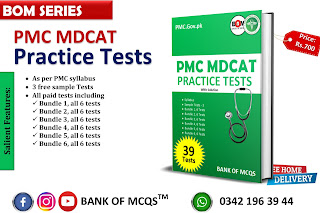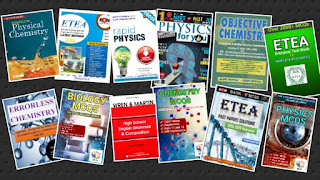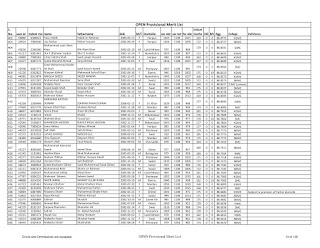Chap.20 Reproduction MCQs
|
1. |
|
|
|
2. |
The
testes are male gonads having lobules: (a)
200 – 300 (b) 200 - 350 (c)
250-300 (d) 250 - 350 |
C |
|
3. |
Male
sex hormones testosterone is produced by the cell present between
seminiferous tubules: (a)
Soma Cell (b) Leyden Cell ©
Epididymis (d) None of
them |
B |
|
4. |
The
no. of vasa different to collect sperms from inside the testes and
transferred to epididymis are: (a)
10-12 (b) 10-15 (c)
10-20 (d) 10 - 25 |
C |
|
5. |
Epididymis
is highly coiled duct with uncoiled length of (a)
10 Feet (b) 20 Feet (c)
30 Feet (d) 40 Feet |
B |
|
6. |
The
duct that moves deep to the pelvic cavity and joins with seminal vesicle to
form short ejaculatory duct is: (a)
Vasa Efferentia (b) Vasa Deferentia ©
Vasa Recta (d) Epididymis |
B |
|
7. |
The
sperm motility will be enhanced by fructose sugar, ascorbic acid and a
coagulative enzyme: (a)
Amylase (b) Ligase (c)
Polymerase (d) Vesiculase |
D |
|
8. |
Semen
is a white, sticky mixture of sperm and secretions of: (a)
Cowper's Gland (b) Bulbourethral
Gland (C)
Prostate Gland (d) Accessory Gland |
D |
|
9. |
The
viscosity of mucus of the uterus of female
reproductive tract will be decreased in semen by: (a)
Prostaglandins (b) Vesiculase. (c) hyaluronidase (d) all of them |
A |
|
10. |
Semen
is slightly alkaline with a pH: (a)
7-7.6 (b) 7.2-7.5 (c)
7.2-7.8 (d) 7.2 7.6 |
D |
|
11. |
The
amount of semen propelled out during ejaculation is 2-5 ml, having sperms in
per milliliter: (a)
10 - 150 Million (b) 20 150 Million (c)
20 - 100 Million (d) 10 - 100
Million |
B |
|
12. |
Gonadotrophin
releasing hormone (GnRH) is responsible
for the stimulation / release of which hormone? (a)
LH (b)
Progesterone ©
Secretin (d) Insulin |
A |
|
13. |
Fertilization
of the ovum normally occurs: (a)
In the upper third of the oviduct (b)
In the uterus (c)
In the lower third of the oviduct (d)
In Vagina |
A |
|
14. |
The
human egg is swept through the oviduct towards the uterus by: (a)
The beating of the egg's cilia (b)
Rhythmic contraction of oviduct (c)
Rhythmic contraction of the uterus (d)
Beating of cilia in the oviduct |
A |
|
15. |
Embryo
implants in the of the uterus. (a)
Perimetrium (b)
Myometrium (c)
Endometrium d) Cervix |
C |
|
16. |
Which
will occur as a result of non-descent of the testes? (a)
Male sex hormones will not be circulated in the body (b)
Sperm will have no means of exit from the body (c)
Inadequate blood supply will retard the development of the testes (d)
Viable sperms will not be produced |
D |
|
17. |
Within
the ovary, progesterone is produced by (a)
Corpus Albicans (b) Corpus Luteum (c)
Tertiary Follicles (d) Primary
Follicles |
B |
|
18. |
The
basie difference between spermatogenesis and oogenesis is that: (a)
During spermatogenesis two more polar bodies are produced (b)
The mature ovum is haploid while the sperm is 2n (c)
Spermatogenesis involves mitosis and meiosis, but oogenesis involves meiosis
only (d)
In oogenesis, one mature ovum is produced and in spermatogenesis four mature
sperms are produced |
D |
|
19. |
The
uterine layer which is shed with each monthly cycle (a)
Endometrium (b) Perimetrium (c)
Tunica Media (d) Myometrium |
A |
|
20. |
Which
is the correct order of the stages of menstrual cycle? (a)
Follicular phase-ovulation-menstruation — Luteal phase (b)
Ovulation - luteal – menstruation follicular phase ©
Follicular phase-ovulation - luteal phase menstruation (d)
Luteal phase-follicular phase – ovulation menstruation |
C |
|
21. |
Reproduction
is very important for the survival of: (a)
Species (b) Individual (c)
Population (d) Both a and b |
D |
|
22. |
Human
sperm was first discovered in 1677 by: (a)
Morgan (b) Landsteiner (c)
Leeuwenhoek (d) Sutton |
C |
|
23. |
Human
ovum was discovered in 1928 by: (a)
Hertwig (b) Edgar
Allen (c)
Von Baer (d) Haeckel |
B |
|
24. |
The
optimum temperature for sperm development is about: (A)20°C. (b) 35 C (c)
37°C (d) 40°C |
B |
|
25. |
The
process of spermatogenesis takes place in: (a)
Seminiferous Tubules (b)
Epididymis (c)
Vas Deferens (d)
Vasa Efferentia |
A |
|
26. |
Testosterone
is produced by: (a)
Sertoli Cells (b)
Leydig Cells (c)
Seminiferous Tubules (d)
Hypothalamus |
B |
|
27. |
Vas
deferens has a length of about: (a)
10 cm (b) 20cm (c)30
cm (d) 45cm |
C |
|
28. |
Ejaculatory
duct is formed by the union of: (a)
Vasa efferentia and epididymis (b)
Epididymis and vas deferens (c)
Vasa efferentia and vas deferens (d)
Duct of seminal vesicle and vas deferens |
D |
|
29. |
How
much semen a human male ejaculates? (a)
2 cm (b) 5cm (c)
10cm (d) 15cm |
B |
|
30. |
The
enzyme vesiculase is present in the secretion of: (a)
Seminal Vesicles (b) Prostate Gland (c)
Cowper's Gland (d) All of these |
A |
|
31. |
Prostaglandins
are chemically (a)
Carbohydrates (b) Proteins (c)
Lipid (d) Enzymes |
C |
|
32. |
Cowper's
gland are also called: (a)
Seminal Vesicles (b)
Prostate Gland (c)
Bulbourethral Glands (d)
Brunner's Gland |
C |
|
33. |
Nourishment
to spermatozoa is provided by: (a)
Leydig Cells (b)
Sertoli (c)
Parietal Cells (d) Chief Cells |
B |
|
34. |
Adult
testes are oval organs of length: (a)
2 cm (b) 5cm (c)
7cm. (d) 9cm |
B |
|
35. |
The
process of the maturation of spermatids into motile and active sperms is
called: (a)
Spermatogenesis (b) Spermiogenesis (c)
Ejaculation (d) None of them |
B |
|
36. |
One
primary spermatocyte gives rise to: (a)
Two Sperms (b)
Four Sperms (c)
Eight Sperms (d) One Sperm |
|
|
37. |
Which
part of the sperm contains mitochondria? (a)
Acrosome (b) Neck (c)
Middle Piece (d) Tail |
C |
|
38. |
Sertoli
cells produce: (a)
Luteinizing hormone (b)
Follicle stimulating hormone (c)
Inhibin (d)
Gonadotrophin releasing hormone |
C |
|
39. |
If
one or both testes fail to descend into the scrotum before birth, this
condition is called: (a)
Cryptorchidism (b) Immaturation (c)
Degeneration (d) Gynaecomastia |
C |
|
40. |
Ovaries
have a length of: (a)
1cm (b)
3.5cm ©
5cm (d) 7cm |
C |
|
41. |
The
wall of uterus is composed of: (a)
Perimetriu (b) Myometrium (c)
Endometrium (d) All of these |
D |
|
42. |
Primary
oocyte undergoes meiotic division to form: (a)
Two ova and two polar bodies (b)
Three ova and one polar body (c)
One ovum and three polar bodies (d)
Four ova only |
C |
|
43. |
Which
glands are present in females? (a)
Cowper's Gland (b) Seminal Vesicles (c)
Prostate Gland (d) Bartholin's
Gland |
D |
|
44. |
Infertility
in men is mot often caused by: (a)
Endometriosis (b) Varicocele (c)
Uterine Fibroids (d) None of them. |
B |
|
45. |
the
spontaneous loss a foetus before the 20th week of pregnancy is called. (a)
Preterm delivery (b) Miscarriage (c)
Parturition (d) Ectopic
Pregnancy |
B |
|
46. |
Which
of the following is a gram negative bacteria? (a)
Neisseria Gonorrhoeae (b)
Treponema pallidum (c)
Both of these (d)
None of them |
C |
|
47. |
red,
painless primary lesion called a chancre is formed in the infection of: (a)
Gonorrhea (b) Syphilis (c)
AIDS (d) All of
these |
B |
|
48. |
Human
ovum has a diameter of about: (a)
2um (b)
20um (c)
100um (d) 10um. |
B |








Comments
Post a Comment